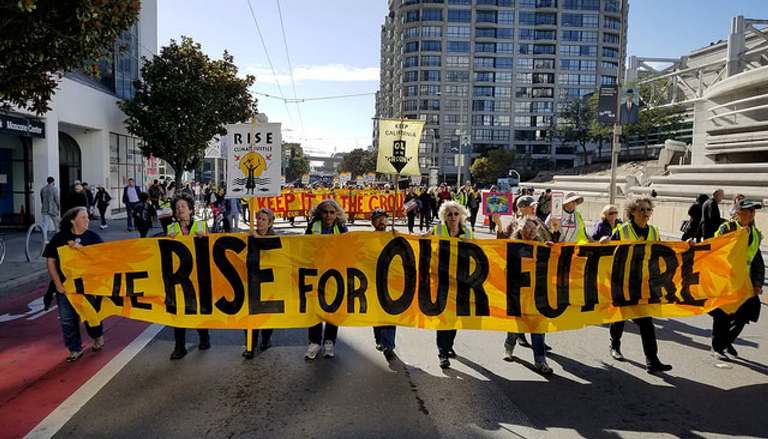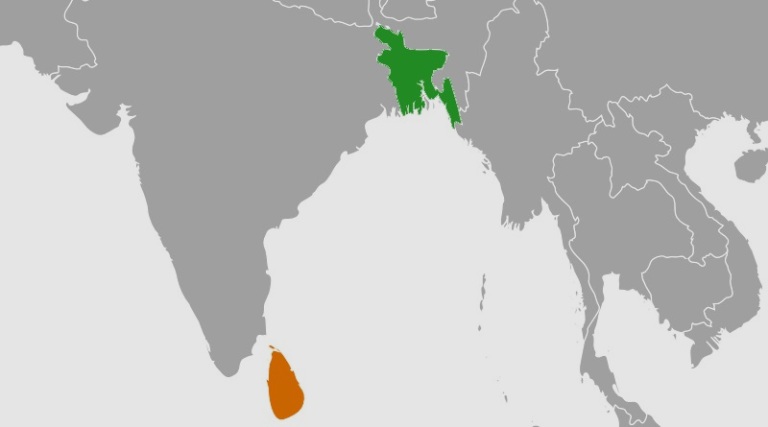
Activists, scientists, business leaders, entertainers and politicians from more than 100 nations gathered in San Francisco for a three-day summit on global warming, 2018. COURTESY
In January, the Netherlands hosted a digital Climate Adaptation Summit where representatives of governments from around the world discussed their post-pandemic recovery plans. To take advantage of remarkably cheap public finance, many emphasized state-directed investments in green infrastructure to promote climate adaptation and stimulate the economy.
Given the increasing evidence that unavoidable shifts in the climate system are already underway, this focus on adaptation should be applauded. But the constitutional implications of increased state interventionism should not be underestimated. Any time a state promises to wield power on a society-wide scale – in this case, to climate-proof the entire economy – the sources and scope of its legitimacy will be hotly debated.
In many countries’ courts, they already are. In 2015, Urgenda, a nongovernmental organization, sued the Dutch government on the grounds that it had failed to protect the Dutch people from the heightened risk that climate change poses to low-lying countries. The implication was that a failure to meet national emissions-reduction targets constitutes evidence of state negligence. In 2019, the Supreme Court in The Hague agreed; ruling in Urgenda’s favor, it compelled the state to pursue larger emissions cuts.
Though the Urgenda case was initially framed as an application of tort law, it ultimately hinged on the obligations of the Dutch state under the European Convention on Human Rights. And because the focus shifted to risks experienced by the entire population, it became a constitutional issue. The Supreme Court’s decision cast the effects of climate change (projected by the science) as an infringement on human rights, and thus ruled that the state has a duty to act. Presumably, the same duty that applies to climate mitigation (emissions cuts) will also apply to investments in adaptation.
Nonetheless, systematic climate adaptation implies a transformation of the physical landscape on a scale that is certain to provoke pushback. In the early twentieth century, the human population tripled with the shift from rural, agricultural societies to urban consumer economies. As a result, expectations changed. A wealthier, enfranchised population could no longer tolerate risks (namely, floods and droughts) that previously had been an accepted part of life.
When the Great Depression arrived, governments responded with infrastructure-led modernization programs designed to control an unruly environment and prevent it from threatening economic growth and stability. The proliferation of dams, embankments, and canals amounted to an extraordinary display of sovereignty. The essence of this technocratic crusade against economic insecurity was similar to what some would like to see in the state’s response to climate change today.
In the United States, the Tennessee Valley Authority became the archetype of state-led modernization. Wielding extraordinary executive power as a federally owned corporation, the TVA could expropriate land in the name of the public interest and command substantial federal resources. Yet despite its success in transforming one of the poorest regions of the US, the TVA faced such strong opposition from those who saw it as federal overreach that no project of its kind has been replicated in the US. Indeed, the response to the TVA sowed the seeds of an anti-infrastructure, anti-dam movement that swept the world in the second half of the twentieth century.
Without a shared understanding of where individual rights end and collective responsibility begins, any systematic transformation of the landscape will be an uphill battle, whatever the intent. Climate-adaption projects cannot become a staple of public policy if they are merely technocratic in nature. Rather, they must embody a new contract between the state and its citizens. There must be a constitutional arrangement that defines the risks a society is willing to endure, and that sets a threshold for taking collective action against intolerable threats.
Because modern constitutionalism developed alongside smallpox and yellow fever crises, public health offers a helpful analogy for how such arrangements arise. In its 1905 decision in Jacobson v. Massachusetts, the US Supreme Court ruled that a community’s right to protect itself against a deadly epidemic allowed it to take action against individuals who refused to be vaccinated against smallpox – including by legislating compulsory inoculation.
In most democracies since then, a century of judicial review has produced a large body of constitutional doctrines conferring legitimacy on state policies to manage public health. These prerogatives have been on full display during the COVID-19 pandemic: government-ordered lockdowns have curtailed individual freedoms in ways that rarely happen without trial.
Citizens have largely accepted these interventions not just because of past jurisprudence, but because of all the social and political history that the legal system has metabolized to get to where it is today. We are the beneficiaries of decades of debate on the importance of public health; of large bodies of epidemiological data, which have won the confidence of both courts and politicians; and of huge investments in a complex web of institutions – government agencies, universities, regulators – that have built trust over time. These and other factors have helped citizens converge on a set of principles making public health a top collective priority.
Humanity has now reached the critical juncture where climate change is acquiring normative value. The evidence justifying concerted state action continues to grow. But while climate adaptation is as urgent and salient an imperative as public health, it has yet to gain the same level of broad-based acceptance.
For climate policy to become more than a technocratic project, governments will need to invest not just in infrastructure and land-use changes, but also in intellectual capital, regulatory institutions, research, and education. Now is the time to drive public engagement in the debates that will define the boundaries between individual rights and collective responsibility in the era of climate change. Insofar as limits on the exercise of state power are the bedrock of modern constitutionalism, the societal embrace of climate adaptation represents a significant constitutional moment.
Giulio Boccaletti, an honorary research associate at the Smith School of Enterprise and Environment, University of Oxford, has been a climate scientist at Princeton University and MIT, a partner at McKinsey & Company, and the chief strategy officer of The Nature Conservancy. He is the author of Water: A Biography.












0 Comments